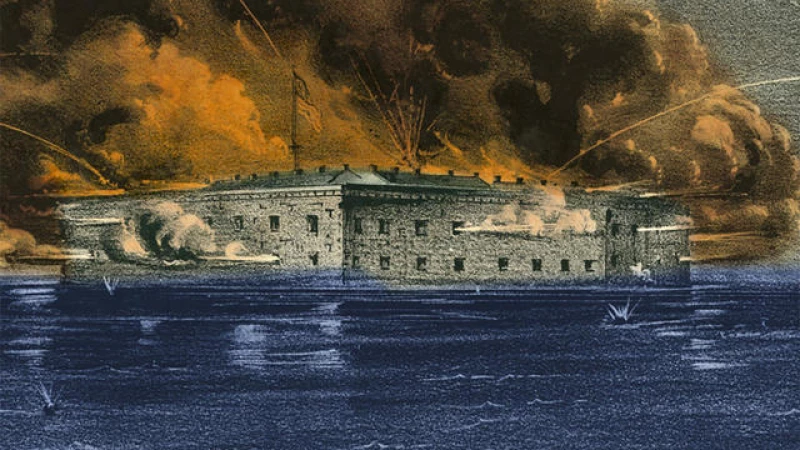The ferry ride to the middle of Charleston Harbor can be a journey back in time. In 1860, Fort Sumter, the federal sea fortress guarding Charleston, became a flash point in the tensions between North and South. "South Carolina saw it as an affront to their sense of honor," said writer Erik Larson. "It was a symbol of everything they felt they were rebelling against."
Larson wrote his new book, "The Demon of Unrest," about the events leading up to the bombardment of Fort Sumter by Confederate forces – the first shots fired in the Civil War. Larson calls it "the single most consequential day in American history,"

Now a national park, Sumter has been altered over the years, but history can still come alive here.
With its 50-foot walls, the fort was almost impenetrable. "The idea was, once fully manned with all the gun ports with heavy artillery, that it would be essentially impregnable," said Larson. "It was designed to defend against seaborne attack from a foreign power. Nobody expected that one day this fort would be the target of fellow Americans."
The author of bestsellers like "The Devil in the White City" and "The Splendid and the Vile," Larson became fascinated with the buildup to the conflict. The mood in Charleston, he said, was a city "ready for rebellion."

Abraham Lincoln had just been elected president of a deeply-divided nation. He'd campaigned to limit slavery, not to abolish it. "The South worked itself up into a condition where they believed that Lincoln represented the apocalypse for Southern culture," Larson said. "They believed no matter what he said, that he was an abolitionist at heart."
Charleston, a center of the slave trade, had 32 slave brokerages. Ryan's Slave Mart was the largest. "It had a showroom where the slaves would get up on a platform and walk back and forth while all the potential buyers were judging them," Larson said.
Soon after Lincoln's election, South Carolina became the first state to secede from the Union. The president-elect had to sneak into the nation's capital in disguise for his inauguration. "The South was so hostile to Lincoln that there were routine death threats," Larson said.
Mason saio, "In terms of the division in society, it's eerily similar to where we are now at times."
"In this period that I'm writing about, the two moments of greatest national dread were the count of the electoral vote and the inauguration – and doesn't that sound familiar?" Larson said.
During Lincoln's inauguration, six more states had seceded from the Union.
Fort Sumter was seen as a threat to the South. Commanded by Major Robert Anderson, a Kentuckian who had taught at West Point, the fort and its 75 men faced Confederate General P.G.T. Beauregard's forces in Charleston.

Beauregard surrounded the harbor with Confederate batteries, creating a tense atmosphere. Anderson, outnumbered 25 to 1, refused to surrender Sumter, knowing it could mean the end of the nation.
Communication from Washington frustrated Anderson, who felt the weight of America's fate on his shoulders.
On April 12, 1861, Confederate guns opened fire on Fort Sumter, leading to a two-day bombardment. Despite over 3,300 shells, the fort's walls held. Anderson eventually surrendered due to fire damage, with no casualties in the attack.
However, 750,000 Americans lost their lives before the Civil War came to an end in 1865.
Exactly four years after the fall of Sumter, Anderson – now a retired general – returned to hoist the American flag over the fort. "The North welcomed him with great admiration; he was seen as a true hero," stated Larson.
On that same night in Washington, President Lincoln was tragically assassinated.
Present-day visitors to the fort have the opportunity to participate in raising the flag every morning. A park ranger noted, "Even though this may seem like ancient history, the events that began here still have a lasting impact on our nation today."
A poignant reminder of the delicate nature of a union … and the sacrifices made to preserve it.

Read an excerpt: "The Demon of Unrest" by Erik Larson
For more information:
- "The Demon of Unrest: A Saga of Hubris, Heartbreak, and Heroism at the Dawn of the Civil War" by Erik Larson (Crown), in Hardcover, Large Print, eBook and Audio formats, available April 30 via Amazon, Barnes & Noble and Bookshop.org
- eriklarsonbooks.com
- Fort Sumter and Fort Moultrie National Historical Park, Charleston, S.C.
- Fort Sumter Tours
- South Carolina Historical Society
- Drone footage by Sumner Crawford of Above All Media
- The Mills House Hotel, Charleston, S.C.
Story produced by Jon Carras. Editor: George Pozderec.
For more info:
- The Civil War, 150 years later ("Sunday Morning")
- Abraham Lincoln and the preservation of democracy ("Sunday Morning")
- Rooted in history: Gettysburg's "Witness Trees" ("Sunday Morning")







